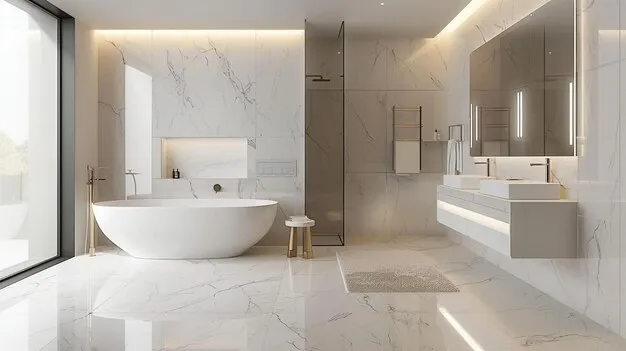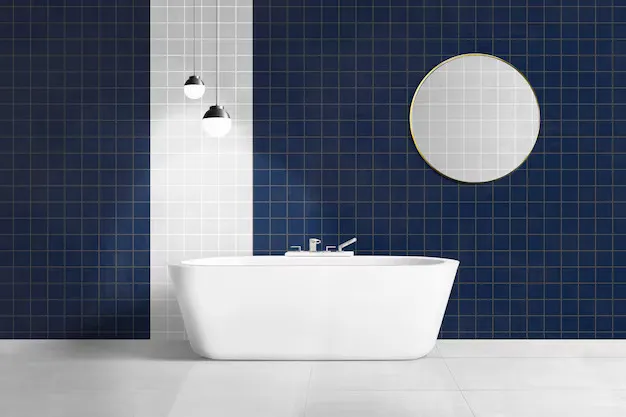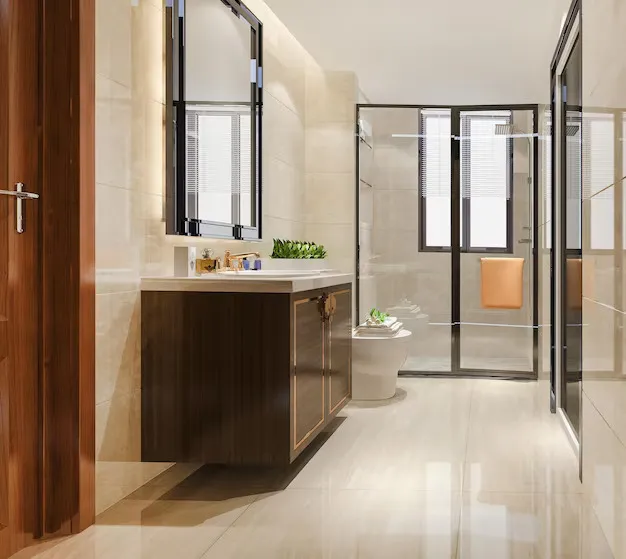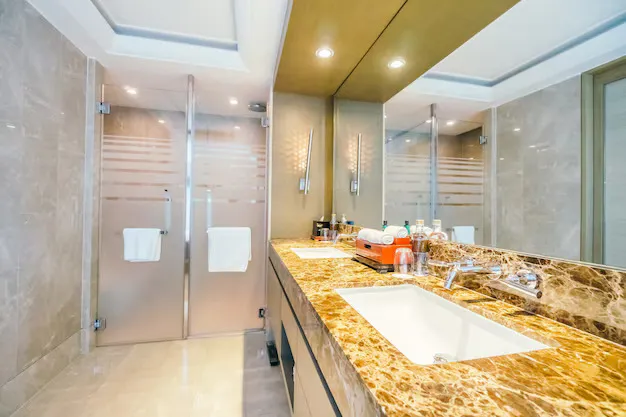Flooring is among the most critical decisions that a homeowner must make when redesigning or developing a bathroom. The flooring should be waterproof to avoid swelling, non-slip, and harmonized with the overall bathroom design. Although there are various options, choosing what can be considered the best tile material for the bathroom floor might be a rather difficult task. That is the reason why here at Glacier Glass we understand just how crucial it can be to get the right bathroom floor tile material that will not only be functional, but that will also be your one-stop solution for elegance. In this article, I will take you through some of the most favorite solutions and then help you make the right decision.
Understanding the Importance of Bathroom Floor Tile Material
Selecting the bathroom floor tile is purely a combinative process of getting the right look and the right sensibility. Begin with the selection of tiles for the floor that should not be slippery especially when wash basins are flooded. Think about how you use your bathroom and choose a tile that suits your needs: porcelain to withstand tough conditions, natural stone for elegance and beauty, and ceramic for versatility. Ensure that when selecting the materials to use, they blend with your personality, the bathroom’s appearance, and cost, but remain fine both in outlook and function. Proper planning and preparation before installing it will make the floor visually appealing, as well as functional.

Explore the Best Options for Your Bathroom Floor
When choosing the best tile material for the bathroom floor, there are a few factors you need to consider. Safety is one of them—avoiding a slippery floor is always advisable. Another is durability—how will the tiles hold up over time? And of course, design plays a major role too. There are endless ways to make your bathroom floors stand out or simply disappear—or an inviting mix of both! We’re sharing why ceramic and porcelain are such popular flooring choices for bathrooms. Plus, the difference between the two and which option is best for your home.
Ceramic Tiles
These are the cheapest in the market and are produced by baking clay and water at low temperatures. They are structurally less sound and may have to be sealed more often to prevent damp from penetrating into the house. Made in different colors, designs and surface treatment, they provide durability and appearance. If one has to make a decision about the best tile for bathroom floor porcelain or ceramic then these tiles have all the features which make them ideal options because of the availability and the reasonable price.
Porcelain Tiles
If you are in search of the best tile material for the bathroom floor then porcelain is for you. Porcelain makes up for ceramics in density and porosity, and therefore it is more capable to endure a more humid climate. They are fired at higher temperatures, this is why they become more solid like and long lasting. Regarding the non-slip characteristics, there are non-slip bathroom floor tiles made of ceramics and porcelain vaults.
Natural Stone Tiles: A Luxurious Option
For luxury seekers, natural stone tiles are a choice that is elegant and timeless. Materials such as marble, granite, slate, and travertine bring about an unmatched kind of beauty that enhances any bathroom. When choosing natural stone, make sure you include it in the materials needed to tile a bathroom floor to achieve that luxurious finish.
Marble Tiles
Marble tiles are loved for their striking veining and luxurious appearance in high-end bathrooms. However, they are more porous than other options and may require frequent sealing to avoid staining.
Granite Tiles
Being harder than marble, granite is less porous hence making a great selection for bathroom floors. Additionally, it comes in different colors and patterns.
Slate Tiles
If you want your bathroom floor to have a rustic feel then slate might be the best tile material for you. It’s anti-slippery and has a unique texture ideal for wet areas thus suitable for such a condition.

Consideration and Verdict
Natural stone tiles usually demand rigorous maintenance, such as the necessity for regular sealing, and they are costlier than ceramics and porcelain. But they do have their beauty and longevity on their side, making it all worth the money. Specifically for the bathroom floors or any other wet areas, this type of tile, such as porcelain, is often used because it is hard to penetrate. However, if properly sealed, the use of ceramic tiles can also be effective. For added safety, consider non slip bathroom floor tiles to ensure traction in wet conditions.
Materials Required to Tile Bathroom Floor
To avoid buying a lot of things unnecessarily, be sure to have a clear plan with measurements of the area. Preparing well will prevent delays and guarantee an easy and successful tiling exercise. Before you start tiling, make sure you have all the materials together, including the best tile material for the bathroom floor. Here are some important aspects to consider:
Tiles
Choose the material that best suits your bathroom floor design as well as your functional needs. When choosing tiles, consider aspects such as durability, slip resistance, and style so that they can meet both aesthetic and practical requirements at the same time.
Tile Adhesive
A strong adhesive will keep your tiles in place. Ensure that you choose one that is suitable for your specific tile material and thus can give you safe fixation. For the best results, follow mixing and application directions from the manufacturer.
Grout
Grout comes in different colors and fills spaces between tiles. The beauty of grout is that it can either match or contrast with the tiles, giving an overall design outlook. Select a grout that goes hand in hand with your bathroom floor tile material’s porosity and complements its color.
Sealer
In case you have porous tiles such as ceramic or natural stone, their vulnerability to moisture can be prevented through sealing. If applied after grouting has set, this would prevent water damage as well as staining, hence ensuring a long life for your tiles.
Underlayment
A proper underlayment could aid in preventing cracks and extra water resistance may be provided. In addition, the tiling job becomes more durable and performs better when it is applied on a smoother surface.
Tile Cutter
The tile cutter helps the tiles to fit perfectly into the space. Precise cuts are important for a professional finish, as well as help save material waste. However, if you only require it for this task, consider either purchasing or renting a good-quality tile cutter.
Spacers
Spacers should be used to ensure even spacing between tiles during installation so that there are uniform grout gaps and neatness, especially when using the best tile material for the bathroom floor, to achieve a professional look for your tile job.

Non-Slip Bathroom Floor Tiles: Safety First
Security is one of the significant concerns related to the bathroom design and one of the effective measures is the selection of non-slip bathroom floor tiles.
Textured Tiles: The tiles having a rough surface will have an added advantage in that they will not cause slipperiness. Choose tiles that are marked ‘porcelain’ or ‘ceramic’ and ‘non-slip’.
Matte Finish: It is also possible to prevent slipperiness by using matte rather than glossy surface treatments on fixtures.
Pebble Tiles: These tiles are found especially on shower floors and give you a natural non-slip surface while at the same time giving your bathroom a statement look.
Consideration: Non-slip tiles are important in increasing the safety of people using the floor, but they are very hard to clean because of the rough surface, thus dirtier than other usual tiles.
Other Considerations for Bathroom Tile Flooring
Beyond the type of tile, there are additional factors to consider when choosing the best tile material for the bathroom floor:
Color and Style
You should not select tile colors and patterns that clash with the rest of the interior design in the bathroom. Pale tones are more suitable for the small bathroom as these will create an illusion of space while intense hues will bring the required dose of sophistication and style into the bathroom.
Size of Tiles
The use of large tiles leads to the perception of the bathroom being a larger area; on the other hand, using small tiles gives the perception of a shower with texture. Consider the tile size to be used and the type of effect the size will have on the outlook of the particular room.
Maintenance Requirements
However, it is also important to mention that not all of these tiles are equally easy to maintain and clean. Porcelain and ceramic are among the easiest to maintain but natural stone requires resealing at frequent intervals and can be cleaned only with special solutions.

Connect with Us: Find Your Perfect Tile
Here at Glacier Glass, we are here to assist you in making the right decision with the best tile material for the bathroom floor. Choosing the right materials for bathroom tile flooring is one of the best ways to make bathrooms stunning, as well as functional to withstand the wear and stresses of daily use and to be safe for years to come. Contact us to learn about your choices in bathroom flooring, and be sure to make the right choice for your home. So why wait? Call us today or simply drop us an email to get the ball rolling!
